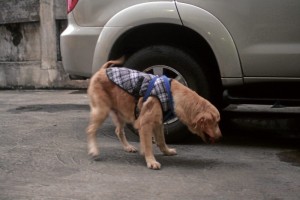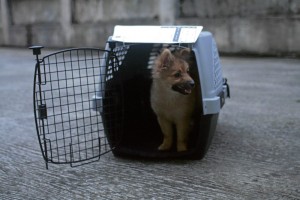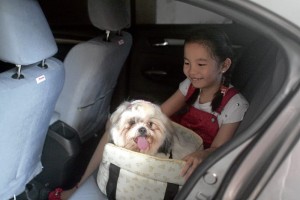The truth about cars and dogs: How to safely transport pets inside your vehicle

GOLDEN Retriever Kisses is wearing a cooling jacket as well as a proper harness—the best way to travel.
The classic image of a dog in a car, immortalized in countless movies, TV commercials and even The Far Side cartoons, is of the pooch freely sitting in the front seat, with its head sticking out the window. While that certainly looks fun, the truth is that car owners who are also pet lovers need to follow certain precautions to keep both themselves and their furry friends safer on the road. Here are the most important ones:
Interestingly, most of the safety rules that apply to kids also apply to pets. Both need extra attention and special equipment before driving off. As with kids, the most important rule is: Put them at the back seat and use proper restraints. During a sudden stop or a crash, a pet that is sitting in the front seat, or more alarmingly, in your lap, will become a helpless projectile. According to a study by Volvo, in a collision at 67 kph, a 27-kg pet will have the crash force of 2000 to 4000 kg—the proverbial elephant in the back seat. Airbags are not a substitute for seatbelts, and for an unbuckled pet in the front seat, airbags can kill or cause serious injury.

FOR FRISKY pets, consider transporting them in a suitable kennel. Get them used to it a few days before your trip.
As seatbelts and child seats are designed for two-legged mammals and not those on four legs, the best restraint is a pet harness. Janine Ngo, marketing manager of Pet Express, recommends choosing a harness appropriate for the dog’s size. The harness wraps around the dog’s chest and forelegs, with a loop on the back for use with the car’s seatbelt. “Pets have a tendency to stick their heads out of the window and might even jump out of a moving car,” Ngo says. Harnesses like the EZDog help prevent this.
Don’t get distracted
A harness will have the added benefit of limiting your pet’s movements within the cabin, and lessens the chances that you will be distracted by having to look after your pet. According to one survey, an alarming 98 percent of dogs do not travel properly restrained. They may move to the front seat or go onto the driver’s lap, interfering with his ability to steer and brake. For pets that are not amenable to harnesses—i.e., cats—use a suitable kennel or crate. The carriers themselves must be secured to the vehicle to avoid them sliding around. Although pickups like the new Ford Ranger have spacious cargo beds ideal for hardware and equipment, these are not suitable for carrying pets, as the hard surfaces and exposure to the elements are not safe for the animals. “Carriers have the added benefit of serving as a comfort zone for pets weary of traveling,” Ngo says.
Article continues after this advertisementPrepare your pet
Article continues after this advertisement
THE TRADITIONAL basket is one way to keep the dog restrained in the back seat… but the best way is still with a proper harness.
Get your pet used to traveling in a car by doing a series of short journeys, gradually lengthening the time that they spend in the car. Avoid feeding your pet within three hours before a ride, and of course, have him relieve himself before the trip. You may also limit water consumption before the ride, but bring along a portable drinker. For dogs that still seem anxious, soothing pills are available, according to Ngo. Some of these read like a recipe for human calmness, too, with ingredients like chamomile and ginger. Plan for plenty of stops so your pet can walk, drink, eat, and relieve itself.
Be alert when stopping the car and opening car doors. Recalls Ngo, “I experienced almost having a heart attack when my over-excited dog darted out of the door and ran right into the street!” Incoming cars were able to stop before running over the dog, but it’s a risk best not taken. “Make sure that your dog is on a leash before opening the car door to let it out.”
Don’t leave your pet alone
Curious dogs can push switches and get stuck in a power window, or put the car in the gear (perhaps deliberately). A parked car gets hot quickly, and running the air conditioner is not a
guarantee of safety. The air conditioner may malfunction and cabin temperature will rise rapidly. Even if a gadget such as a cooling jacket helps make your pet more comfortable, these are not meant to ward off potential heat stroke from a hot car interior.
Aside from your pet’s food and water container, bring along his leash, medication and plastic bags for waste cleanup. A favorite toy may also help calm your pet through the presence of a familiar object. The toy will occupy the pet’s attention and lessen the chances of it bothering you while driving, according to Ngo.
Care for your car, too
While traveling with pets may be fun and rewarding, don’t forget that your car needs care, too. Pet accessory stores carry seat protectors that help keep your car clean and safe from the inevitable hair and “accidents.” Your car will need a good vacuuming after a trip, or even a full detailing to keep its interior clean and fresh.
With child safety awareness slowly gaining ground, the time is ripe to also watch out for your pets that ride with you in the car. Keeping them safe and satisfied on a trip is a responsibility, and its own reward. And please, keep their heads inside the vehicle at all times.
